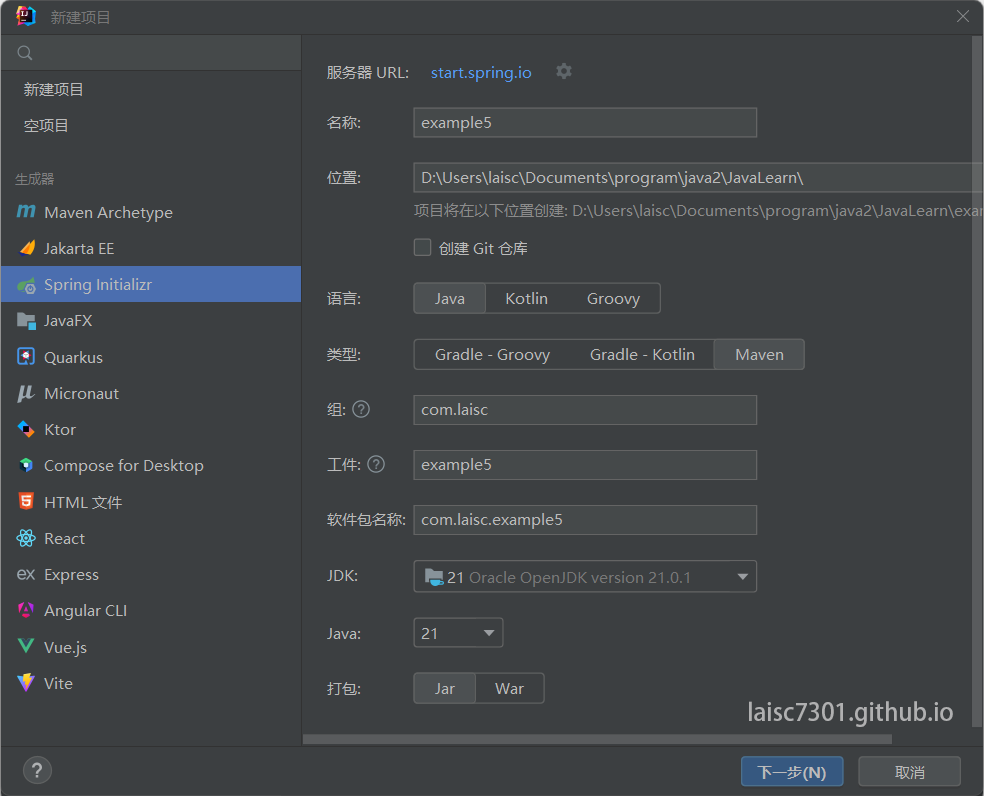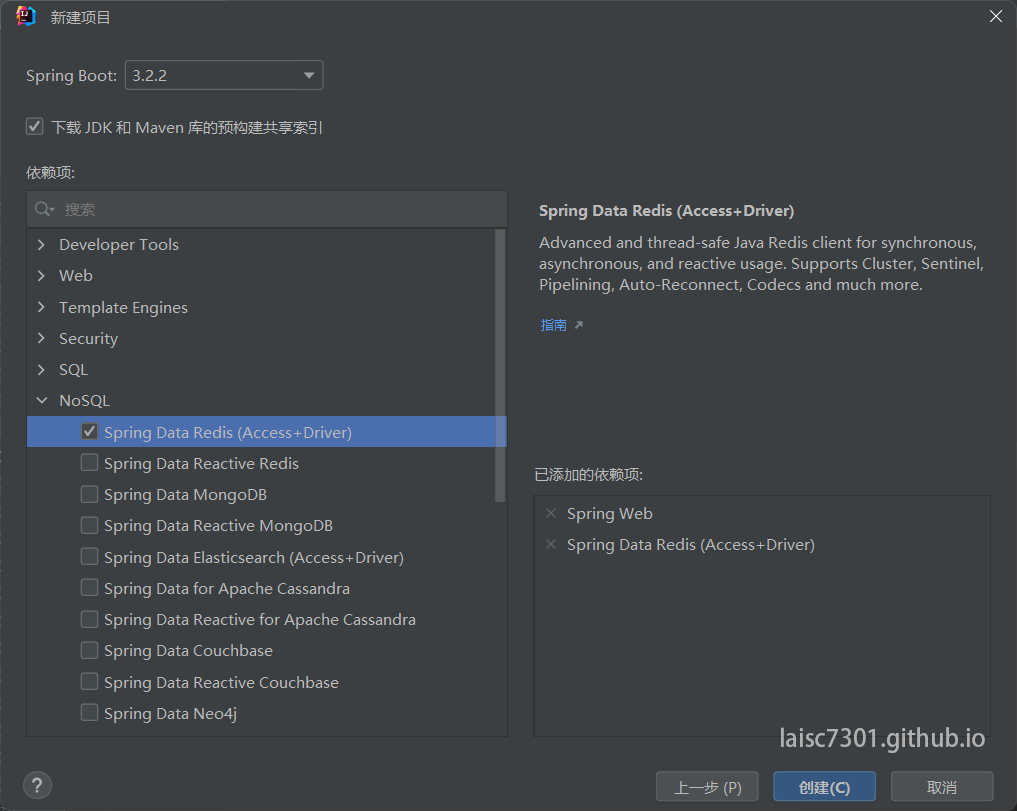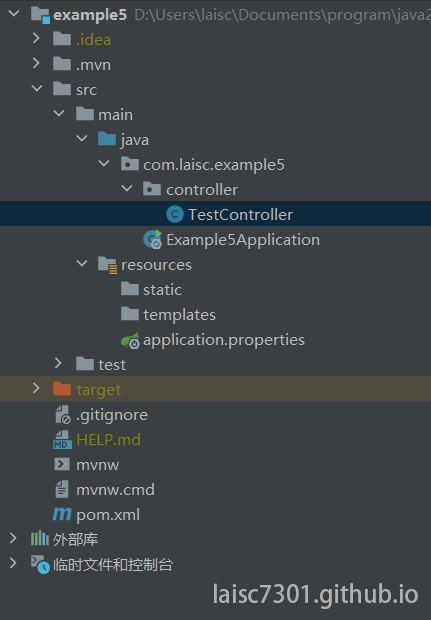1
2
3
4
5
6
7
8
9
10
11
12
13
14
15
16
17
18
19
20
21
22
23
24
25
26
27
28
29
30
31
32
33
34
35
36
37
38
39
40
41
42
43
44
45
46
47
48
49
50
51
52
53
54
55
56
57
58
59
60
61
62
63
64
65
66
67
68
69
70
71
72
73
74
75
76
77
78
79
80
81
82
83
84
85
86
87
88
89
90
91
92
93
94
95
96
97
98
99
100
101
102
103
104
105
106
107
108
109
110
111
112
113
114
115
116
117
118
119
120
121
122
123
124
125
126
127
128
129
130
131
132
133
134
135
136
137
138
139
140
141
142
143
144
145
146
147
148
149
150
151
152
153
154
155
156
157
158
159
160
161
162
163
164
165
166
167
168
169
170
171
172
173
174
175
176
177
178
179
180
181
182
183
184
185
186
187
188
189
190
191
192
193
194
195
196
197
198
199
200
201
202
203
204
205
206
207
208
209
210
211
212
213
214
215
216
217
218
219
220
221
222
223
224
225
226
227
228
229
230
231
232
233
234
235
236
237
238
239
240
241
242
243
244
245
246
247
248
249
250
251
252
253
254
255
256
257
258
259
260
261
262
263
264
265
266
| package com.laisc.example5.controller;
import org.springframework.beans.factory.annotation.Autowired;
import org.springframework.data.redis.core.RedisTemplate;
import org.springframework.data.redis.core.SetOperations;
import org.springframework.data.redis.core.StringRedisTemplate;
import org.springframework.stereotype.Controller;
import org.springframework.web.bind.annotation.RequestMapping;
import org.springframework.web.bind.annotation.ResponseBody;
import java.util.HashMap;
import java.util.List;
import java.util.Map;
import java.util.Set;
import java.util.concurrent.TimeUnit;
@Controller
@RequestMapping("/test")
public class TestController {
@Autowired
private RedisTemplate redisTemplate;
@Autowired
private StringRedisTemplate stringRedisTemplate;
@ResponseBody
@RequestMapping("/setvalue1")
public String setValue1() {
redisTemplate.opsForValue().set("测试1", "测试123");
String out = redisTemplate.opsForValue().get("测试1").toString();
return out;
}
@ResponseBody
@RequestMapping("/setmapvalue")
public String setMapValue() {
Map<String, String> map = new HashMap<>();
map.put("aaa", "bbb");
map.put("ccc", "ddd");
redisTemplate.opsForValue().set("map1", map);
String out = redisTemplate.opsForValue().get("map1").toString();
return out;
}
@ResponseBody
@RequestMapping("/setvalue2")
public String setValue2() {
stringRedisTemplate.opsForValue().set("测试2", "测试1234");
String out = stringRedisTemplate.opsForValue().get("测试2");
return out;
}
@ResponseBody
@RequestMapping("/setvalue3")
public String setValue3() {
stringRedisTemplate.opsForValue().set("测试3", "测试12345", 3600, TimeUnit.SECONDS);
String out = stringRedisTemplate.opsForValue().get("测试3");
return out;
}
@ResponseBody
@RequestMapping("/setexpire")
public boolean setExpire() {
return stringRedisTemplate.expire("测试2", 3600, TimeUnit.SECONDS);
}
@ResponseBody
@RequestMapping("/persist")
public boolean persist() {
return stringRedisTemplate.boundValueOps("测试3").persist();
}
@ResponseBody
@RequestMapping("/haskey")
public boolean hasKey() {
return stringRedisTemplate.hasKey("测试2");
}
@ResponseBody
@RequestMapping("/del")
public String del() {
String out = stringRedisTemplate.delete("测试2").toString();
return out;
}
@RequestMapping("/addset")
@ResponseBody
public String addSet() {
SetOperations<String, String> set = stringRedisTemplate.opsForSet();
set.add("myset", "22");
set.add("myset", "33");
set.add("myset", "44");
Set<String> resultSet = stringRedisTemplate.opsForSet().members("myset");
return resultSet.toString();
}
@RequestMapping("/addset2")
@ResponseBody
public String addSet2() {
stringRedisTemplate.opsForSet().add("myset", "1", "2", "3");
Set<String> resultSet1 = stringRedisTemplate.opsForSet().members("myset");
return resultSet1.toString();
}
@RequestMapping("/addvalue")
@ResponseBody
public String addValue() {
Long mycounter = stringRedisTemplate.boundValueOps("counter").increment(1);
return mycounter.toString();
}
@RequestMapping("/getexpire")
@ResponseBody
public String getExpire() {
Long time = stringRedisTemplate.getExpire("测试3");
return time.toString();
}
@ResponseBody
@RequestMapping("/listpush")
public String listPush() {
stringRedisTemplate.opsForList().rightPush("myList", "1");
stringRedisTemplate.opsForList().rightPush("myList", "2");
stringRedisTemplate.opsForList().rightPush("myList", "A");
stringRedisTemplate.opsForList().rightPush("myList", "B");
stringRedisTemplate.opsForList().rightPush("myList", "C");
stringRedisTemplate.opsForList().leftPush("myList", "0");
return "ok";
}
@RequestMapping("/getlist")
@ResponseBody
public String GetList() {
List<String> listAll = stringRedisTemplate.opsForList().range("myList", 0, -1);
List<String> list = stringRedisTemplate.opsForList().range("myList", 0, 3);
return "listAll=" + listAll.toString() + " list=" + list.toString();
}
@RequestMapping("/listremove")
@ResponseBody
public String listRemove() {
stringRedisTemplate.opsForList().remove("myList", -2, "B");
return "ok";
}
@RequestMapping("/hashput")
@ResponseBody
public String hashPut() {
stringRedisTemplate.opsForHash().put("mytest:test1", "a", "b");
stringRedisTemplate.opsForHash().put("mytest:test1", "c", "d");
stringRedisTemplate.opsForHash().put("mytest:test1", "e", "f");
return "ok";
}
@RequestMapping("/hashget")
@ResponseBody
public String hashGet() {
Map<Object, Object> map = stringRedisTemplate.opsForHash().entries("mytest:test1");
return map.toString();
}
@RequestMapping("/hashdel")
@ResponseBody
public String hashDelete() {
stringRedisTemplate.opsForHash().delete("mytest:test1", "a", "e");
return "ok";
}
@RequestMapping("/hashgetkeys")
@ResponseBody
public String hashGetKeys() {
Set<Object> objects = stringRedisTemplate.opsForHash().keys("mytest:test1");
return objects.toString();
}
@RequestMapping("/hashgetvaluelist")
@ResponseBody
public String hashGetValueList() {
List<Object> objects = stringRedisTemplate.opsForHash().values("mytest:test1");
return objects.toString();
}
@RequestMapping("/hashsize")
@ResponseBody
public String hashSize() {
long size = stringRedisTemplate.opsForHash().size("mytest:test1");
return String.valueOf(size);
}
}
|


